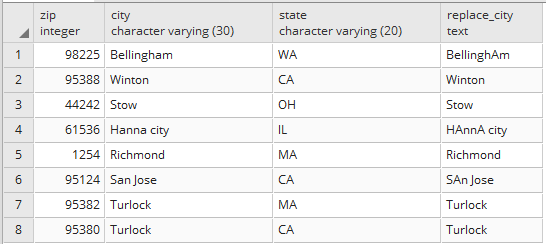
The key word ILIKE can be used instead of LIKE to make the match case-insensitive according to the active locale. PostgreSQL's behavior in this regard is therefore slightly nonstandard. This effectively disables the escape mechanism, which makes it impossible to turn off the special meaning of underscore and percent signs in the pattern.Īccording to the SQL standard, omitting ESCAPE means there is no escape character (rather than defaulting to a backslash), and a zero-length ESCAPE value is disallowed. It's also possible to select no escape character by writing ESCAPE ''. See Section 4.1.2.1 for more information. If you have standard_conforming_strings turned off, any backslashes you write in literal string constants will need to be doubled. To match the escape character itself, write two escape characters. The default escape character is the backslash but a different one can be selected by using the ESCAPE clause. To match a literal underscore or percent sign without matching other characters, the respective character in pattern must be preceded by the escape character. Therefore, if it's desired to match a sequence anywhere within a string, the pattern must start and end with a percent sign.

LIKE pattern matching always covers the entire string. An underscore ( _) in pattern stands for (matches) any single character a percent sign ( %) matches any sequence of zero or more characters.

If pattern does not contain percent signs or underscores, then the pattern only represents the string itself in that case LIKE acts like the equals operator. An equivalent expression is NOT ( string LIKE pattern).) (As expected, the NOT LIKE expression returns false if LIKE returns true, and vice versa. The LIKE expression returns true if the string matches the supplied pattern.
Postgresql replace null how to#
So, in this article, we saw how to replace null values in a column.9.7.1. When we execute the query, we will get Sam, Sara, Michael, and Null (because both the rows are null), Female, and Aiden Pearce. SELECT P_Id, COALESCE(Name,Gender) AS FROM tblPerson Pass the column names separated by commas as a parameter. There are two nulls in the Name column and three nulls in the Gender column, and with the help of COALESCE, we will get the first non-null value from both of the columns. The COALESCE() function returns the first NON NULL value. If the column value is not null, then it will print the following column value: WHEN ColunName IS NULL THEN 'replacementValue' If the column value is null, that value will be replaced with the "replacementValue". Pass the column Gender in the parameter of the ISNULL function, and in the second parameter, pass the replacement value. Now let's do the same for the Gender column.

So, now all the null values are replaced with No Name in the Name column. To use this function, you only need to pass the column name in the first and second parameters and pass the value with which you want to replace the null value. The ISNULL Function is a built-in function to replace nulls with specified replacement values. For example, replace null with "no name" for the name column and replace null with "no gender" for the gender column. Now let's say there is a requirement to replace all these null values with meaningful text. The preceding query returns many columns with null values. The following is the query for creating this table. P_Id is the primary column of this table. The table has three columns: P_Id, Name, and Gender. To replace null with a specified replacement value, we can use any of the following:įor the demo, we will be using this tblPerson table.


 0 kommentar(er)
0 kommentar(er)
